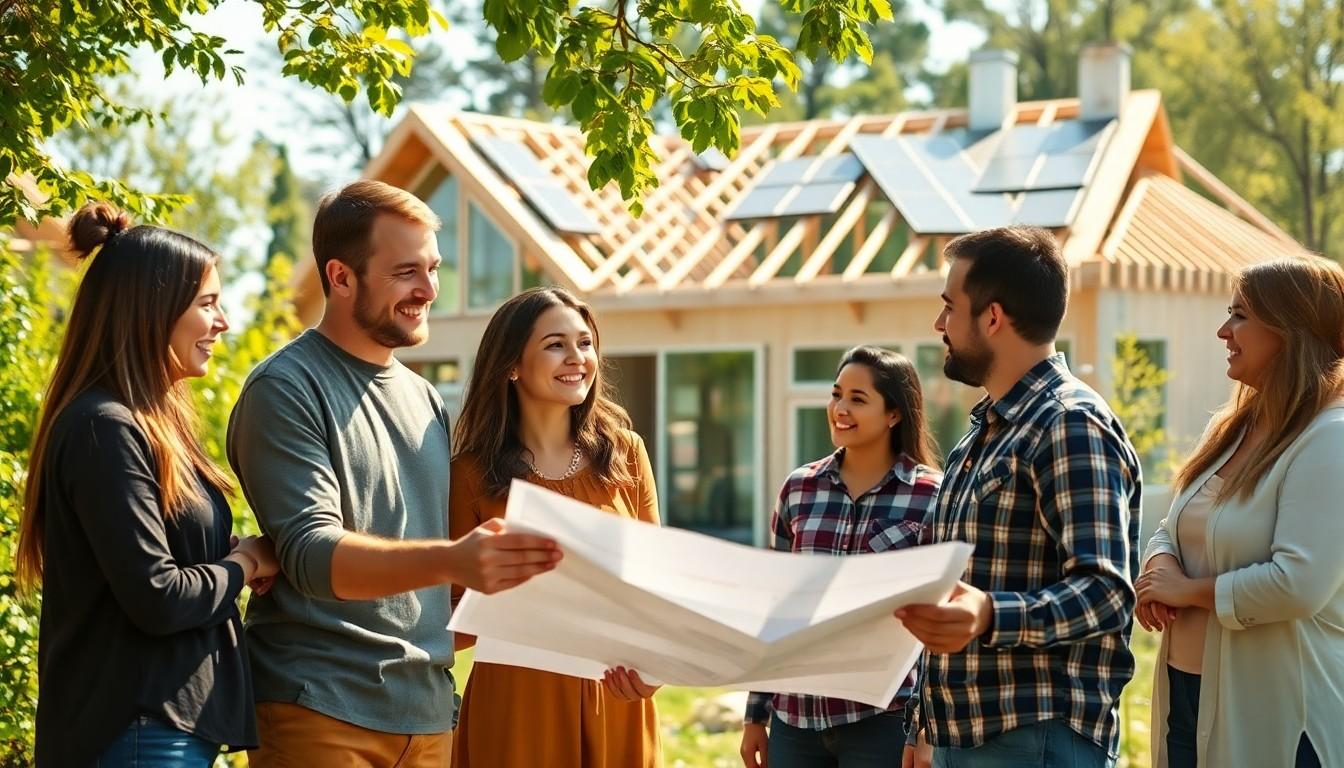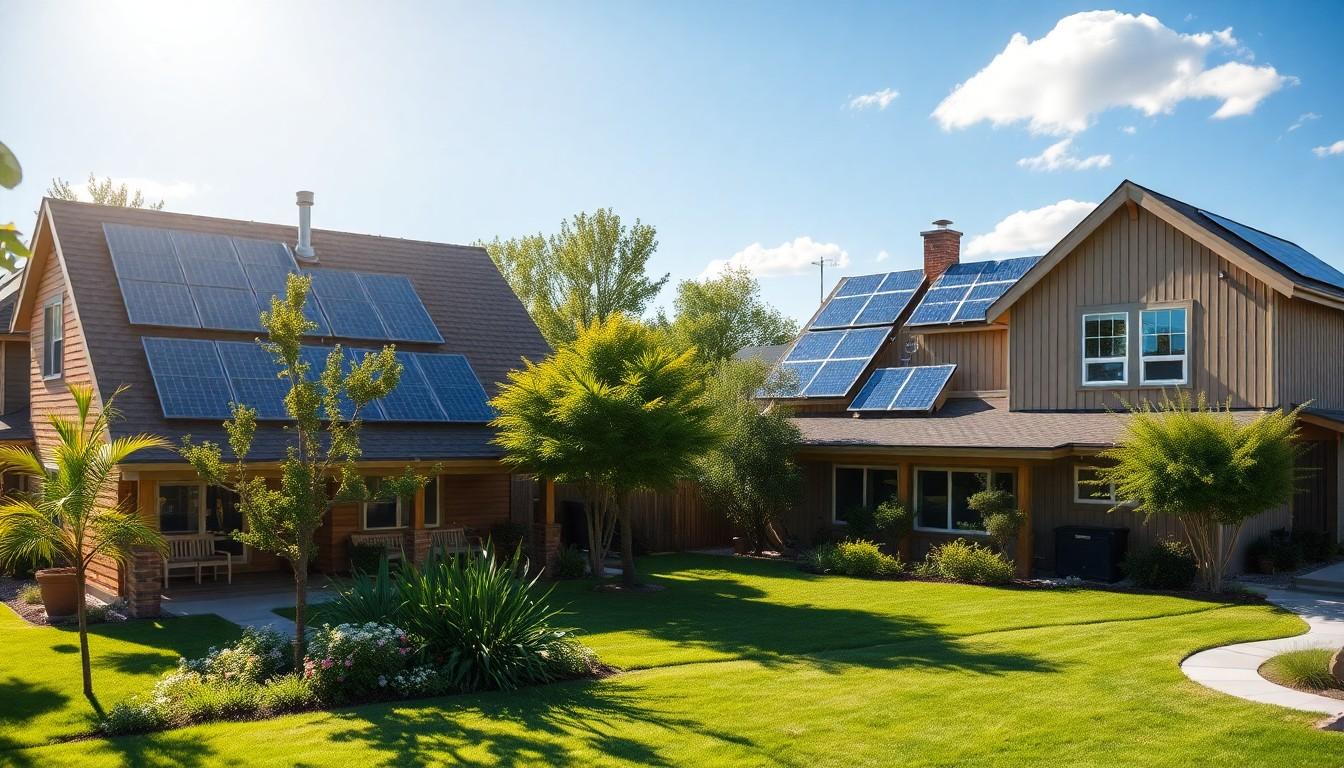Phone:
(701)814-6992
Physical address:
6296 Donnelly Plaza
Ratkeville, Bahamas.

Building a home doesn’t have to mean sacrificing the planet. Eco-friendly home building is like giving Mother Nature a high-five while also creating a cozy nest for yourself. Imagine living in a space that not only looks good but also feels good—good for you and the environment. It’s a win-win that makes your neighbors green with envy.
Eco-friendly home building integrates sustainable practices, materials, and designs to create environmentally responsible residences. Sustainable construction focuses on minimizing waste and reducing carbon footprints. Features like energy-efficient appliances, high-performance insulation, and renewable energy sources contribute to a home’s efficiency.
Design choices often include orienting structures to maximize natural light and ventilation, enhancing comfort while reducing reliance on artificial heating and cooling systems. Materials sourced locally help reduce transportation emissions, promoting sustainability in the building process.
Water conservation strategies play a key role in these homes. Rainwater harvesting systems and efficient plumbing fixtures minimize water usage significantly. Using permeable paving allows for natural water absorption, reducing runoff and promoting groundwater recharge.
Several certification programs encourage green building practices. The Leadership in Energy and Environmental Design (LEED) certification offers guidelines for sustainable practices in home construction. Similarly, the National Green Building Standard (NGBS) provides a foundation for environmentally sound building measures.
Bamboo and reclaimed wood serve as popular eco-friendly material options. Both promote sustainable forestry practices while showcasing unique aesthetics within the home. These materials require fewer resources to produce and generate less waste.
Investing in eco-friendly home building yields long-term financial benefits. Homeowners often enjoy lower energy bills and increased property values due to these sustainable features. Additionally, communities benefit from decreased environmental impacts, creating a healthier living environment for all residents.

Eco-friendly home building presents numerous advantages, significantly enhancing both individual lives and the environment.
Sustainable construction practices greatly reduce a home’s carbon footprint. By incorporating renewable energy sources, such as solar panels, homeowners can minimize reliance on fossil fuels. Water conservation methods, including rainwater harvesting, support reducing water waste. Choosing eco-friendly materials, like bamboo or recycled steel, lessens the impact on natural resources. Enhancing insulation and energy efficiency reduces energy consumption, leading to a lower environmental toll. Overall, green building fosters healthier ecosystems and promotes biodiversity through responsible land use.
Homeowners experience substantial cost savings through eco-friendly building practices. Minimizing energy consumption leads to lower utility bills over time. Increased energy efficiency often results in tax incentives and rebates from local governments. Property values typically rise when homes feature sustainable elements, making them more attractive to buyers. The durable materials used in eco-friendly construction can decrease maintenance costs, saving money in the long run. Investing in sustainable housing not only benefits the wallet but also enhances the community’s economic resilience.
Eco-friendly home construction relies on the use of materials that reduce environmental impact while providing durability and aesthetics. Selecting the right materials plays a critical role in sustainability.
Sustainable sourcing focuses on using materials obtained from responsibly managed resources. This approach minimizes ecological damage and supports local economies. Bamboo, for instance, grows rapidly and regenerates quickly, making it a top choice for flooring and furniture. Similarly, using locally sourced stone or wood reduces transportation emissions. Furthermore, materials certified by organizations like the Forest Stewardship Council indicate sustainable practices. They ensure that the sourcing process remains transparent and ethical. Choosing sustainable materials contributes to energy efficiency and overall environmental health.
Recycled materials form an essential component of eco-friendly construction. Utilizing reclaimed wood, for example, prevents deforestation and reduces waste in landfills. Steel and glass are also commonly recycled, offering both strength and versatility for construction projects. Incorporating these materials often leads to unique design elements, enhancing aesthetic appeal while maintaining ecological integrity. Cities increasingly promote the use of recycled materials through incentives, impacting both the economy and the environment positively. By opting for recycled options, builders contribute to a circular economy, where resources are utilized responsibly and repetitively.
Designing eco-friendly homes focuses on sustainability and efficiency. Key principles guide builders in creating environments that minimize ecological impact.
Energy efficiency serves as one of the core principles in eco-friendly home design. Homeowners benefit from utilizing energy-efficient appliances, which significantly reduce energy consumption. High-performance insulation enhances thermal comfort while lowering heating and cooling costs. Renewable energy sources, like solar panels, generate clean energy and diminish reliance on non-renewable resources. Natural daylighting through strategically placed windows reduces the need for artificial lighting. Home design should also consider smart home technologies that optimize energy use and monitor consumption patterns.
Optimizing space utilization plays a vital role in eco-friendly home building. Efficient floor plans maximize usable square footage while minimizing unnecessary construction. Open-concept designs facilitate airflow and reduce the need for excessive walls. Multi-functional spaces support diverse activities, allowing rooms to serve multiple purposes. Builders emphasize decluttered designs that make the most of space, minimizing the overall footprint of homes. Sustainable landscaping further enhances outdoor area functionality, creating spaces that are both aesthetically pleasing and practical.
Innovative technologies play a crucial role in advancing eco-friendly building practices. Smart home systems optimize energy use, allowing homeowners to monitor and adjust consumption efficiently. Integration of energy management systems provides real-time data, facilitating decision-making for sustainable living.
Advanced insulation materials, such as aerogel and structural insulated panels, significantly enhance thermal performance. These materials contribute to consistent indoor temperatures while reducing heating and cooling costs. Many builders now utilize sustainable roofing technologies, like green roofs and cool roofs, which help regulate building temperatures and manage stormwater.
Renewable energy technologies, particularly solar panels and wind turbines, have become standard in eco-friendly construction. Solar photovoltaic systems generate clean electricity, while solar water heaters supply hot water efficiently. Wind energy systems supplement these efforts, further decreasing reliance on fossil fuels.
Prefabricated construction methods reduce waste and construction time, leading to more efficient building processes. Many companies now produce modular homes assembled from eco-friendly materials that decrease the ecological footprint of construction. Additionally, 3D printing technology facilitates the creation of homes using recycled materials, promoting sustainability at every stage of the building process.
Water conservation technologies play a vital role in eco-friendly design. Rainwater harvesting systems collect and reuse water for irrigation, while low-flow fixtures reduce overall water consumption. Advanced greywater recycling systems recycle water from sinks and showers for landscape use, enhancing sustainability further.
Innovative technologies in eco-friendly building prioritize sustainability and efficiency, significantly impacting both homeowners and communities. By embracing these advancements, builders create homes that reduce environmental footprints while promoting healthier living environments.
Embracing eco-friendly home building is a powerful step toward a sustainable future. By prioritizing energy efficiency and sustainable materials, homeowners not only enhance their living spaces but also contribute to the well-being of the planet.
The shift toward green building practices fosters healthier communities and drives economic resilience. Investing in innovative technologies and sustainable design principles creates homes that are not only beautiful but also environmentally responsible.
As more people recognize the benefits of eco-friendly construction, the movement toward sustainable living continues to gain momentum, paving the way for a greener tomorrow.